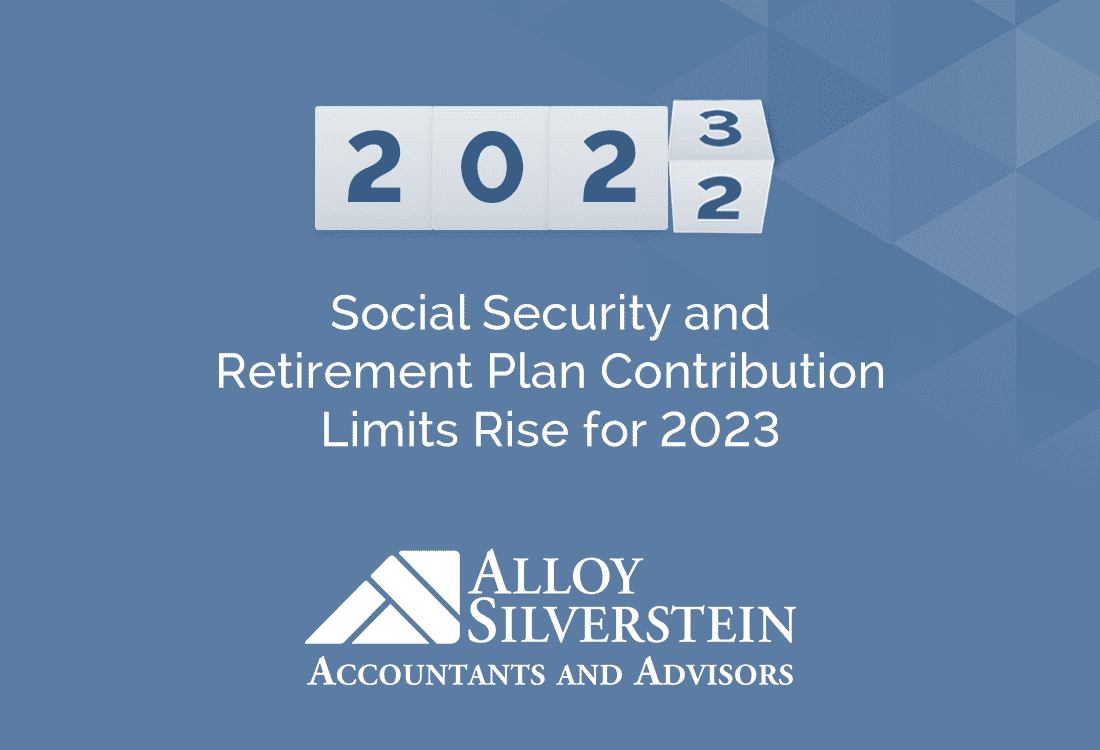
Inflation continues to impact the cost of living, and the IRS and SSA are taking notice. The following updates have been announced over the past week and may impact your 2023 tax planning and finances. Turn to an Alloy Silverstein CPA if you have questions on your individual situation.
The contribution limit for employees who participate in 401(k), 403(b), most 457 plans, and the federal government’s Thrift Savings Plan is increased to $22,500, up from $20,500.
The limit on annual contributions to an IRA increased to $6,500, up from $6,000. The IRA catch‑up contribution limit for individuals aged 50 and over is not subject to an annual cost‑of‑living adjustment and remains $1,000.
The amount individuals can contribute to their SIMPLE retirement accounts is increased to $15,500, up from $14,000.
The catch-up contribution limit for employees aged 50 and over who participate in 401(k), 403(b), most 457 plans, and the federal government’s Thrift Savings Plan is increased to $7,500, up from $6,500. Therefore, participants in 401(k), 403(b), most 457 plans, and the federal government’s Thrift Savings Plan who are 50 and older can contribute up to $30,000, starting in 2023. The catch-up contribution limit for employees aged 50 and over who participate in SIMPLE plans is increased to $3,500, up from $3,000.
The income ranges for determining eligibility to make deductible contributions to traditional IRAs, Roth IRAs, and to claim the Saver’s Credit all increased for 2023:
The income phase-out range for taxpayers making contributions to a Roth IRA is increased to between $138,000 and $153,000 for singles and heads of household, up from between $129,000 and $144,000. For married couples filing jointly, the income phase-out range is increased to between $218,000 and $228,000, up from between $204,000 and $214,000. The phase-out range for a married individual filing a separate return who makes contributions to a Roth IRA is not subject to an annual cost-of-living adjustment and remains between $0 and $10,000.
The income limit for the Saver’s Credit (also known as the Retirement Savings Contributions Credit) for low- and moderate-income workers is $73,000 for married couples filing jointly, up from $68,000; $54,750 for heads of household, up from $51,000; and $36,500 for singles and married individuals filing separately, up from $34,000.
How much you pay and checks received are all going up: The Social Security Administration announced a whopping 8.7% boost to monthly Social Security and Supplemental Security Income (SSI) benefits for 2023. This is on the heels of a 5.9% increase last year. The increase is based on the rise in the Consumer Price Index over the past 12 months ending in September 2022.
For those contributing to Social Security through wages, the potential maximum income subject to Social Security tax increases to $160,200. This represents a whopping 9% increase in your Social Security Tax! Here’s a recap of the key dollar amounts:
| Maximum Taxable Earnings | $160,200 (Up $13,200 from 2022) |
|
| Retirement Earnings Test Limits | Under Full Retirement Age: Year You Reach Full Retirement Age: |
$21,240 / year* $56,520 / year** |
| * One dollar in benefits will be withheld for every $2 in earnings above the limit (up from $19,560 in 2022). ** Applies to earnings in months prior to attaining full retirement age. One dollar in benefits will be withheld for ever $3 in earnings above the limit (up from $51,960 in 2022). |
||
| SSI Federal Payment Standard | Individual: Couple: |
$914 / month $1,371 / month |
| SSI Student Exclusion | Monthly Limit: Annual Limit: |
$2,220 $8,950 |
The Social Security and Medicare tax rates do not change from 2022 to 2023.
| Tax Rate | 2022 | 2023 |
|---|---|---|
| Employee | 7.65% | 7.65% |
| Self-Employed | 15.30% | 15.30% |
Note: The above tax rates are a combination of 6.20 percent Social Security and 1.45 percent for Medicare. There is also a 0.9 percent Medicare wages surtax for single taxpayers with wages above $200,000 ($250,000 for joint filers) that is not reflected in these figures. Please note that your employer also pays Social Security and Medicare taxes on your behalf. These figures are reflected in the self-employed tax rates, as self-employed individuals pay both halves of the tax.
Empowering business owners and individuals in South Jersey and Philadelphia to feel confident through proactive accounting and advisory solutions.